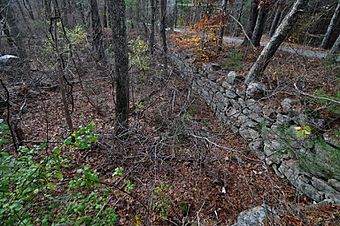Fisherville Historic and Archeological District facts for kids
Quick facts for kids |
|
|
Fisherville Historic and Archeological District
|
|
 |
|
| Location | Exeter, Rhode Island |
|---|---|
| Area | 27 acres (11 ha) |
| Architectural style | Greek Revival |
| NRHP reference No. | 80000017 |
| Added to NRHP | December 5, 1980 |
The Fisherville Historic and Archeological District is a special place in Exeter, Rhode Island. It's like a time capsule that helps us learn about the past. This area is centered around Fisherville Brook, where a busy mill complex once stood in the mid-1800s.
A historic district is a special area that has important buildings or places from the past. These places are protected so we can study and appreciate them.
Contents
What is the Fisherville Historic District?
The Fisherville Historic and Archeological District is a protected area in Exeter, Rhode Island. It covers about 27 acres (11 hectares) of land. This district helps us understand how people lived and worked long ago.
The district is found in the northeastern part of Exeter. It is built around Fisherville Brook, which was important for powering the old mills.
The Busy Mills of Fisherville
In the mid-1800s, Fisherville was a busy place because of its mills. A mill complex is a group of buildings that use water power to run machines. These machines helped people make important goods.
The district includes the old foundations of a gristmill and a sawmill. A gristmill was used to grind grain into flour. A sawmill cut logs into lumber for building. These mills were very important for the local community.
What Remains Today?
Today, you can still see the foundational remnants of these old mills. This means the stone or brick bases are still there. They show us where the buildings once stood. These remnants help archeologists study how the mills were built and used.
A Glimpse into the Past: The Cape House
When the Fisherville District was first studied in 1980, it also included an old house. This house was built in the early 1800s. It was a "Cape style" house, which is a common type of home from that time.
Even though it was abandoned, this house helped tell the story of the area. It showed what homes looked like when the mills were active.
Why is Fisherville Important?
The Fisherville Historic and Archeological District is important because it teaches us about history. It shows how communities grew around natural resources like brooks. It also shows us how people used technology, like water-powered mills, to create things.
Listed on the National Register
Because of its historical value, the Fisherville site was added to the National Register of Historic Places in 1980. The National Register is a list of places in the United States that are important to our country's history. Being on this list helps protect these sites for future generations.
Images for kids




